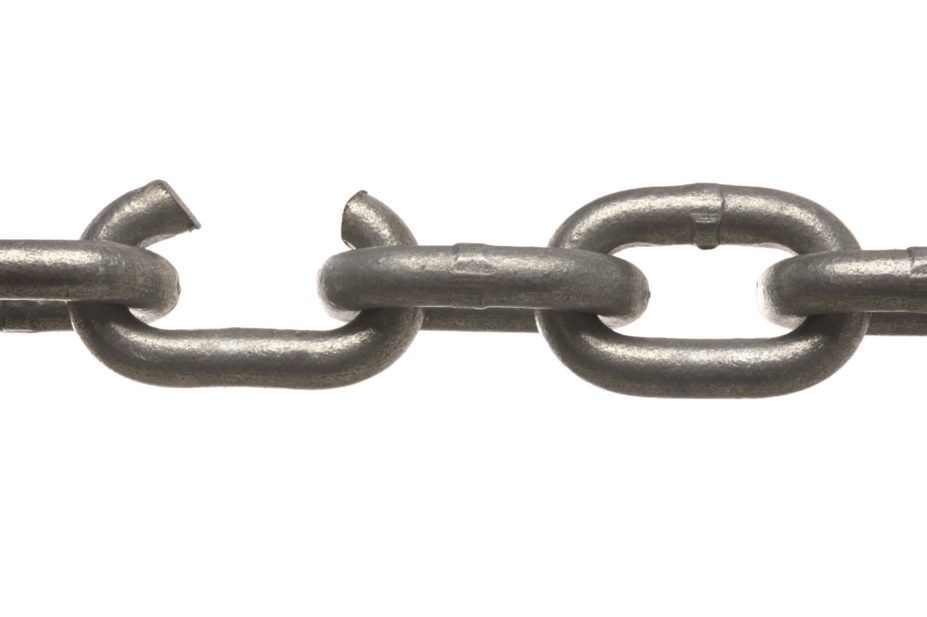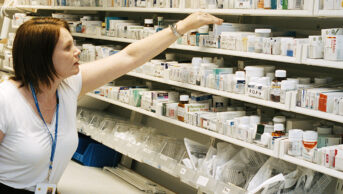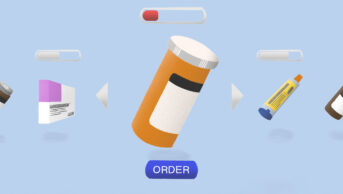
Shutterstock.com
When Jennifer LaCognata began experiencing attacks of night blindness, she was understandably worried. So she was relieved to find that the cause was a simple vitamin A deficiency, which could easily be remedied by regular vitamin A injections.
She started having injections of Aquasol A, but then the manufacturer, Hospira, stopped making the product, prompting a worldwide shortage. There was no alternative product Jennifer could turn to, so she began having problems with her sight again. She searched the United States and then the world for remaining vials of the drug, but to no avail.
Now blind in one eye and losing her sight in the other, Jennifer decided to sue Hospira. She lost. The judge said that Hospira did not have a duty to supply her or the market in general with the drug. Nor was Hospira in breach of US Food and Drug Administration (FDA) regulations, he said, because the company was not required to obtain FDA approval to stop supplying a prescription product to the market.
This case is just one example of the effect that drug shortages can have on patients. It highlights the importance of regulatory organisations trying to ensure that patients have access to a continued supply of drugs, even if they cannot take responsibility for guaranteeing that supply.
Jennifer’s problems coincided with other severe drug shortages and litigation in the United States, prompting the US government to give the FDA stronger powers in a bid to prevent shortages. Unfortunately it’s a different story in Europe, where regulatory authorities are doing little to collect information on shortages or to intervene where they occur.
It is essential to tackle this “information gap” and “responsibility gap” at a European level, according to Roberto Frontini, president of the European Association of Hospital Pharmacists (EAHP).
The European Medicines Agency (EMA) is responsible for drug approvals, but monitoring and responding to drug shortages is primarily the responsibility of national agencies. As a result, there are no comprehensive, publicly available European data on which drugs are in short supply and why, and the information available in individual countries is highly variable. Crucially, manufacturers do not have to warn European regulatory authorities of a likely shortage, and there is no coordinated European action to mitigate shortages or to ensure that the remaining stock is targeted at the patients most in need. European pharmacy and patient groups are therefore asking the European Commission to strengthen the role of the EMA, pointing out that there has been a dramatic fall in drug shortages in the United States since legislation was introduced to give the FDA more powers.
Europe’s problem
Surveys by the EAHP show that drug shortages in Europe are extensive and affect every European country. Of the 537 hospital pharmacists in 36 European countries who responded to a question in the EAHP’s 2014 survey[1]
, 86% said that shortages were a current problem in the hospital where they worked, with almost half saying they were affected by shortages on a weekly basis (see ‘Frequency and impact of shortages in hospitals’)1. Three-quarters of 369 respondents agreed or strongly agreed that shortages were having a negative impact on patient care.
The survey reveals shortages across all categories of medicine. Worryingly, says Frontini, Europe seems to be moving from having a shortage of some generic drugs — which creates work for pharmacists in sourcing alternatives but does not really affect patient care — to having shortages of critical drugs, including antibiotics, cancer drugs, anaesthetics and emergency medicines. Branded medicines were considered to be the category of drugs most often in short supply by 51.8% of hospital pharmacists[1]
in 2014, up from 42.9% in a survey[2]
conducted in 2013.
There are acceptable alternatives for many of the drugs in short supply, but substituting a drug in an emergency situation can be very dangerous, Frontini points out, because staff need to be able to follow routines and standard procedures. “If you have to use two ampoules [of a drug] instead of one, or the opposite, then you can make really big dosage mistakes,” he says.
Shortages of medicines can occur for a variety of reasons. Quality-control issues can lead to the shutdown of a drug production line, or even of an entire facility producing numerous drugs. Other production problems, including breakdowns or difficulties in sourcing raw active pharmaceutical ingredients or other components (such as stoppers, vials or containers), can also lead to a slowing of production or a complete shutdown.
Increased demand for a product can also cause shortages, as existing production facilities may not be able to meet the demand. In some instances, a company may decide to stop producing a medicine altogether, perhaps for commercial reasons, such as switching production to a more profitable product. Global consolidation of production, often to one or a handful of production sites, can also create supply-chain vulnerabilities when quality, production or transport issues affect a particular site.
In addition, local, usually short-term, shortages can arise because of wholesaler distribution problems. More serious long-term shortages at a national level may also result from differences in pricing between countries. In a free market, such as the European Union, parallel trading between countries is permitted, and market forces result in the flow of medicines from countries where prices are lower, such as Greece and Spain, to countries with higher prices, such as Germany.
Obama acts
Information about which drugs are in short supply, and why, is much easier to obtain in the United States than in Europe because the FDA has a searchable public database listing drugs in shortage, along with a daily information feed including updates from manufacturers.
The FDA says that almost 70% of shortages are related to either facility- or product-specific quality issues. In most cases they are facility related, meaning that several drugs made by a manufacturer are affected. In 2011, there were shortages of oncology drugs owing to manufacturing problems at one company, and in 2012 there was a shortage of intravenous nutrition drugs because a manufacturer closed down.
In 2014, the most critical shortage was of intravenous fluids, says Valerie Jensen, associate director of the FDA’s drug-shortages programme. “That has not really been a quality problem — there’s not been a manufacturer that has shut down or had any major issues — it has been mostly increased demand, so capacity has been tight,” she explains. “We need more manufacturing lines and we need more facilities making that drug. We are working with companies to increase their capacity, which they are doing.” This was a US-specific shortage, so the FDA looked overseas for additional supplies.
Drug shortages quadrupled in the United States between 2005 and 2011. “In 2011 we started seeing a large spike in shortages, and that was really due to quality problems at large injectables manufacturers,” Jensen explains. The companies involved had to slow down or stop production to address the problems, resulting in shortages.
“Many of those drugs were oncology drugs and anaesthesia drugs, which are absolutely needed for hospitals and patients,” Jensen says. “We know that patients were affected. There were times when patients had to have therapy delayed, and then they had to substitute other products that might not be the best drug for that patient.”
At the time, there was no requirement for a company to inform the FDA if they stopped producing a drug. “If they found a problem at the plant, or they made a business decision that they might stop making one drug and make a different drug for various reasons, they had no requirement to tell us that. We would mostly find out about the shortages once that had hit the hospital level, when the patients had already been affected.”
The situation prompted President Barack Obama to issue an order in 2011 to tackle the problem. The resulting Food and Drug Administration Safety and Innovation Act, passed in 2012, requires pharmaceutical companies to notify the FDA of any potential supply disruption.
This led to a six-fold increase in notifications to the FDA, which was also granted extra resources to help it work with companies to reduce the number, length and impact of shortages. The FDA helps manufacturers to address production or quality issues at their own plant, and talks to other manufacturers that produce the same or a similar drug to make them aware of the impending increased demand at an early stage so they can increase production to fill the gap.
FDA figures show that drug shortages in the United States have since fallen from their 2011 peak of 251 products to 117 in 2012 and 44 in 2013. Jensen says that the number for 2014 will be similar to that in 2013.
While the number of new shortages has decreased quite substantially, as a direct result of the law that was enacted, Bona Benjamin, director of medication-use quality improvement at the American Society of Health-System Pharmacists, says the absolute figures are higher because the FDA only lists medically necessary drugs and new shortages, and doesn’t consider delays in the supply chain. “Shortage information frequently changes, we are following around 300 active shortages daily,” she says.
“We are still having issues as regards the existing shortages, or what we call ‘the frequent fliers’ — ones that may go back into production for a month, and then they are back on the shortage list,” says Joe Hill, assistant director of government affairs at the American Society of Health-System Pharmacists. “Those are the ones that have been more stubborn to being completely resolved.”
Impact on patients
It is difficult to quantify the impact of drug shortages on patients in Europe because the effects are not monitored or reported, according to François Houÿez, director of treatment information and access at the European Organisation for Rare Diseases (EURORDIS). Where a drug substitution is made from the start of a course of treatment, patients are usually unaware that the medicine prescribed is not their doctor’s first choice. They often only learn of a shortage when they renew a regular prescription and find that the drug is not available.
An alternative can often be prescribed, although it may not be as effective, or it might cause side effects or need to be given at a different dose, which may lead to errors. Sometimes, however, there is no alternative available, or the alternative is ineffective. In such cases, the disease can resume.
Between 2009 and 2013, quality issues at Genzyme’s manufacturing facilities meant that the company had to stop production of Fabrazyme (agalsidase beta), which is used to treat Fabry disease, and Cerezyme (imiglucerase), for Gaucher disease. The EMA’s advice was to reduce the dosage for some patients[3]
.
One patient in the Netherlands who had his Cerezyme dose lowered needed a liver transplant after the disease process resumed. “Even when he was put back on a higher dose, they realised that his liver would not function properly,” Houÿez explains.
Meanwhile, 12% of patients whose Fabrazyme dose was lowered experienced worsening disease, including strokes, severe pain and collapse3. The EMA then recommended that some patients were switched to an alternative enzyme replacement therapy called Replagal (agalsidase alfa), but because of the drug’s complex manufacturing process, the manufacturer, Shire, was not able to ramp up production quickly to meet the demand.
Between 2011 and 2013, quality issues were identified at Ben Venue laboratories, a facility that makes products for a number of companies, leading to 12 medicines being suspended. For two of these — the anticancer drugs Caelyx (pegylated doxorubici
n
hydrochloride) and Ceplene (histamine didydrochloride) —
no alternative medication was available.
Regulators at the EMA faced a dilemma, says Houÿez. “Leaving the product on the market could harm the patient, but suspending it could also harm the patient.” The EMA recommended keeping the product on the market, but shortages followed. Some patients were being treated with Caelyx, which is indicated for breast cancer, multiple myeloma, ovarian cancer and Kaposi’s sarcoma, because all other treatments had failed3. Unfortunately the cancer returned in some patients who had experienced remission, says Houÿez.
Potential solutions
In 2013, 45 patient and healthcare groups, including the EAHP, EURORDIS and the Pharmaceutical Group of the European Union (PGEU), which represents community pharmacists, issued a statement outlining the dangers of drug shortages and saying what they think needs to be done by the EMA, public authorities, the pharmaceutical industry and others3.
First, they say, the EMA should collect data on supply shortages and make the information publicly available. In 2013, the EMA established a public catalogue of shortages that it says “includes information on medicine shortages that affect or are likely to affect more than one European Union (EU) member state, where the EMA has assessed the shortage and provided recommendations to patients and healthcare professionals across the EU”.
Frontini says that although the EMA’s online shortages catalogue is a step in the right direction, it doesn’t provide a full picture of medicine shortages in Europe because of its restricted criteria for inclusion. He believes that the EMA needs to be given a clearer legal mandate to be active in this area. “It would also help the EMA if all medicines agencies in Europe could operate their own national databases of medicines currently in shortage, in the way that countries like Spain, the Netherlands, Italy and Belgium do,” he adds. Some other European countries, including Germany, France and England, also have databases, but they either limit what is included or do not make them publicly available[4]
.
The report from the 45 patient and healthcare groups also suggests that a reporting mechanism should be established to allow healthcare professionals and patients to report product shortages to the authorities.
As soon as a shortage seems possible, particularly for a product where this could have severe consequences for public health, manufacturers should have to inform the EMA and relevant healthcare professional and patient organisations, even if this may create false alerts in some cases, the group says. In a statement to The Pharmaceutical Journal, the EMA says: “There is an obligation in the legislation for marketing authorisation holders to inform the EMA if they plan to withdraw a medicine from the market due to manufacturing or quality issues.” However, additional legislation would be required to cover decisions made for commercial reasons, or to require potential shortages to be reported. “The EMA does not follow shortages related to capacity issues or problems in distribution, as this is the responsibility of the national competent authorities,” the statement explains.
At the end of last year, four groups representing the pharmaceutical industry — the Association of the European Self-Medication Industry (AESGP), the European Federation of Pharmaceutical Industries and Associations (EFPIA), the European Generic Medicines Association (EGA) and the Plasma Protein Therapeutics Association (PPTA) — issued a joint document[5]
calling for a harmonised approach to processes for notifying quality and manufacturing issues across national regulatory authorities and the EMA. Harmonising trigger points, timings and the content and format of notifications would enable regulators to gather standardised data for identifying and analysing causes, and to develop mitigation strategies, they say.
One market
Patient and healthcare groups would like to see a European office established to help prevent and resolve shortages, and to communicate information on shortages to patients and health professionals. The office would work with companies to help avoid or minimise the effects of a shortage, and would contract other manufacturers to increase production where necessary3.
Any company applying for marketing authorisation for essential medicines should have to produce a supply-shortage risk assessment plan as part of its application, the patient and healthcare group says. This should detail how its production capacity will be able to satisfy demand and explain the measures it could take if demand is higher than anticipated or there are manufacturing problems.
Where shortages occur, the group adds, the allocation of remaining supply to European countries should be decided by the EMA and its scientific committees, with consultation from healthcare professionals and patients. Otherwise there is a major risk that most of the remaining stock will go to countries that pay a higher price for medicines, such as Germany, while countries that pay lower prices, such as Greece and Spain, will have access to very little, says Houÿez.
During the recent economic crisis in Greece, the government reduced the cost of medicines by 10–20%, resulting in national shortages of some medicines because they were exported outside the country where they could fetch higher prices, Houÿez says. A subsequent survey in 2012 by market research company Ipsos found that 39% of Greek patients with rare diseases who were prescribed an orphan drug could not get the treatment they needed, along with 11% of patients with chronic diseases.
European law allows EU members to take measures to ensure security of supply where there is a genuine risk of shortages, such as requiring wholesalers to obtain consent to export, restricting pharmacists’ wholesale activities and, in exceptional circumstances, using limited export bans where there is a risk to patient safety. Greece took this step in October 2012 by imposing export bans on almost 80 drugs[6]
.
“Instead of fuelling market distortions, leaving patients in lower income, lower price countries worse off, the objective must be to move away from importing low priced products from other countries to having an affordable price in each market based on objective criteria,” says EFPIA6. In a position paper on the issue, EFPIA says that European countries “would be encouraged to abolish the distortive effects of national schemes rewarding parallel trade to the detriment of exporting countries”. It calls for more consistent and robust enforcement of existing obligations on supply-chain operators to improve the integrity of the supply chain and improve transparency within it. In particular, EFPIA seeks the use of more accurate supply and demand data to verify regulatory compliance and to identify potential supply shortages at an early stage.
Patients and healthcare groups agree. Their common position statement3 says: “The Commission and Council of Ministers should engage in a full review of the operation of the pricing system in Europe and whether it is best ensuring access to medicines for European patients in the overall sense, including, but not restricted to, its impact on medicine shortages.”
Frontini warns that leaving responsibility for pharmacovigilance in the hands of national authorities “is not possible in a unified Europe where the market is one market”. Instead, he says, “we need something European and covering the needs of European people, and not covering national interests, because this is against the spirit of Europe.”
Where there are shortages, European and international coordination is needed “to ensure fair and adequate distribution of remaining supply”, and medical criteria should be agreed to target remaining stocks at those patients most in need, the patient and healthcare groups say. In cases of extreme shortage, where no clear biomedical criteria can allocate a limited supply fairly, random allocation (drawing lots) should be used.
Representatives of the patient and healthcare groups met with the European Commission in late 2014 to discuss their proposals.
We are asking the Commission to legislate to require companies to notify the EMA of shortages, even when the shortage is still uncertain, Frontini says. He also wants to empower the EMA to follow up notifications of expected shortages, to work to mitigate them, and to prepare a public database.
He adds: “I am optimistic that the Commission is opening a discussion with the EMA, and that they will take some action.”
References
[1] European Association of Hospital Pharmacists. Medicines Shortages in European Hospitals: The Evidence and Case for Action (2014).
[2] European Association of Hospital Pharmacists. EAHP Policy Briefings: Medicines Shortages in European Hospitals (2013).
[3] European Association of Hospital Pharmacists. EAHP Policy Briefings: Medicines Shortages in European Hospitals (2013).
[4] Common Position between Patients’, Consumers, and Healthcare Professionals’ Organisations involved in the Activities of the European Medicines Agency on: Supply Shortages of Medicines (2014).
[5] Pauwels K, Huys I, Casteels M & Simoens S. Drug shortages in European countries: a trade-off between market attractiveness and cost containment? BMC Health Services Research 2014;14: 438.
[6] AESGP, EFPIA, EGA & PPTA Quality and Manufacturing Driven Supply Disruptions: Industry Communication Principles to Authorities (2014).
You may also be interested in

Medicines shortages and slow approvals put ‘significant burden’ on pharmacists, says report

An ‘Argos’ model could give patients the access to medicines they deserve
